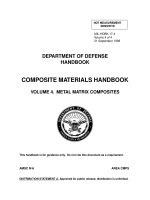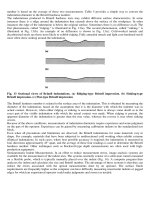Volume 4 fuel cells and hydrogen technology 4 10 – solid oxide fuel cells theory and materials
Bạn đang xem bản rút gọn của tài liệu. Xem và tải ngay bản đầy đủ của tài liệu tại đây (37 KB, 1 trang )
4.10
Solid Oxide Fuel Cells: Theory and Materials
A Tesfai and JTS Irvine, University of St Andrews, St Andrews, UK
© 2012 Elsevier Ltd. All rights reserved.
4.10.1
Introduction
4.10.1.1
Fuel Cells
4.10.1.2
Thermodynamics
4.10.1.3
The Nernst Equation
4.10.1.4
The SOFC
4.10.1.4.1
Principles of operation
4.10.1.4.2
Advantages of SOFC over other types of fuel cell
4.10.1.5
SOFC Components
4.10.1.5.1
Electrolyte
4.10.1.5.2
Cathode
4.10.1.5.3
Anode
4.10.1.5.4
Interconnect
4.10.1.6
Example Systems
4.10.1.6.1
Introduction to CHP systems
4.10.1.6.2
Efficiency and efficiency limits
4.10.1.6.3
Heat and power load requirements for a typical UK home
4.10.1.6.4
Fuel cell-based micro-CHP systems
4.10.1.6.5
Performance characteristics
4.10.1.6.6
Fuel cell micro-CHP technical specifications and functional requirements
4.10.1.6.7
Efficiency
4.10.1.6.8
Durability
4.10.1.6.9
Fuel cell heat-to-power ratio and its advantages
4.10.1.6.10
Engineering methods to achieve a variable heat-to-power ratio
4.10.2
Conclusion
Acknowledgment
References
Glossary
Anode Where oxidation occurs, typically a fuel
electrode.
Cathode Where reduction occurs, typically the air
electrode.
Electrolyte Ion conducting membrane separating fuel and
air electrodes.
241
242
243
245
246
246
246
246
246
247
247
248
249
249
250
251
251
251
251
252
252
253
254
254
255
255
Fugacity Equal to the pressure of an ideal gas which has
the same chemical potential as the real gas.
Gibbs free energy Thermodynamic potential that
measures the ‘useful’ work.
Interconnect Gastight electrical connection between
anode and cathode.
PEMFC Polymer electrolyte membrane fuel cell.
4.10.1 Introduction
The increasing demand for energy due to economic growth particularly in developing countries on one hand and increasingly
energy-intensive lifestyles and trends on the other hand is posing a serious environmental sustainability challenge. The problem of
whether these competing demands for energy can be satisfied in a future of shrinking fossil fuel resources [1, 2] and global warming
[3, 4] is causing a serious concern. In recent years, this has intensified the search for more reliable and sustainable energy sources.
Currently, due to rapid depletion of oil reserves, natural gas and coal have been increasingly used as alternatives. However, it is
now widely accepted that long-term sustainable energy supply can only be achieved with the use of renewable energy sources
(RESs). Some of the potential RESs are wind, solar, and tidal energy systems. Electrochemical devices such as fuel cells will play an
important role both to provide clean hydrogen gas for mobile application and also for converting fuel to energy more efficiently
than conventional systems.
International experts agree that the optimal strategy and principles for addressing the energy and greenhouse gas (GHG)
emissions is first to minimize energy losses through efficient use of fossil fuels; second to introduce cost-effective RESs – solar
Comprehensive Renewable Energy, Volume 4
doi:10.1016/B978-0-08-087872-0.00411-X
241









